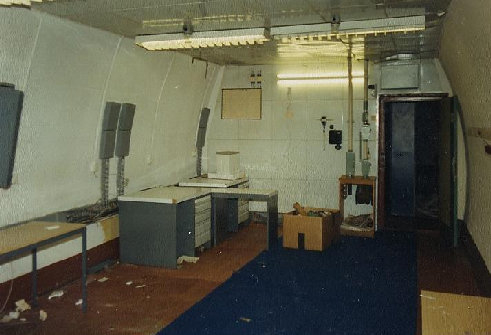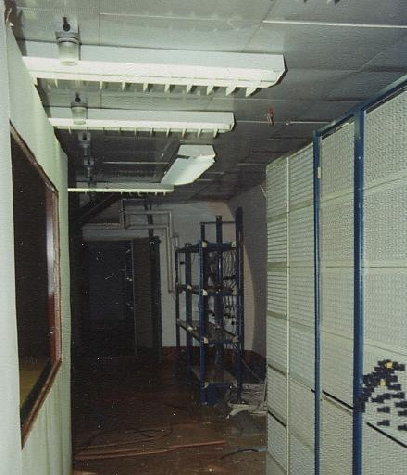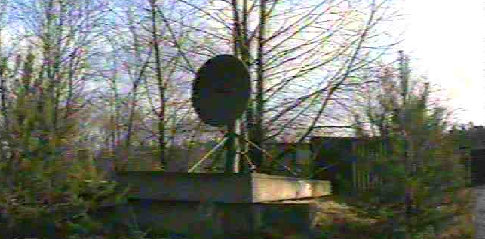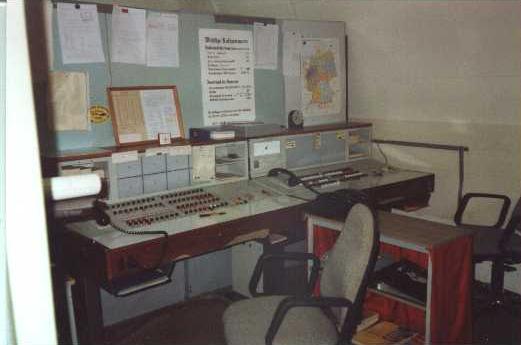Die Nachrichtenzentrale im „Fuchsbau“

Hier waren quer 6 Tischreihen mit den Arbeitsplätzen der Funker aufgestellt.
Die Zuordnung ist noch an den links an der Wand befindlichen Fm-Verteilern zu sehen.
Neben der Tür ist links die Rohrpostanlage zu erkennen.
Die Arbeitsplätze der Funker in den Führungsfunknetzen waren mit automatischen Morsegebern MG-80 ausgestattet.

Der Raum mit der offenen Fernschreibvermittlung, allerdings zu BW-Zeiten.

Blick in die Reste der Funkempfangszentrale. Hinten rechts befand sich die Alarmierungszentrale (WAZ).
Hinter der links erkennbaren Wand mit dem Fenster hatten der DNZ (Diensthabender der Nachrichtenzentrale) und der D-FuZ (Diensthabender der Funkzentrale) ihre Arbeitsplätze.
Dahinter bis zum erkennbaren Durchgang waren Fernmeldeverteiler und Empfangsgerätetechnik aufgestellt.
Auf der rechten Seite im Vordergrund ist ein Kreuzschienenverteiler aufgebaut.
Mit Hilfe der zu steckenden Amphenol-Tucheln erfolgte die Zuordnung verschiedener Nachrichtenkanäle an unterschiedliche Nutzungsvarianten.
Dahinter sind nur noch Reste einer Gestellwand zu erkennen. Sie reichte bis an den Kreuzschienenverteiler heran.
Aufgestellt darin war die Empfangsgerätetechnik (überwiegend EKV-13, EKD-111, EKD-300)
Das Nachrichten-Betriebsbataillon im ZGS-14 war verantwortlich für die offenen und gedeckten Fernsprech- und Fernschreibverbindungen über Draht und Funk, den Faksimilie-Empfangsbetrieb für die Flugwetterwarte ZFWW, die Richtfunkverbindungen, die Rohrpostverbindungen im Schutzbauwerk, die TV-Übertragung im Bauwerk sowie auch der Tonübertragung der Nationalhymne der DDR zur täglichen Vergatterung.
Die Führung dieser Prozesse im 24-Stunden-Dienst oblag dem Diensthabenden der Nachrichtenzentrale.
Ihm unterstellt waren mehr als 30 Fernsprecher/-schreiber, Chiffreure, Abfertiger, Empfangs- und Sendefunker und Techniker der Übertragungsstelle.
Die eingesetzten Funker wurden durch eigenes Personal ausgebildet.
Die besten Funker erreichten im 3. Diensthalbjahr ein Tempo von 100 Zeichen pro Minute mit der Handtaste.


Die Übertragung der Signale aus dem „Fuchsbau“ erfolgte über eine getarnte Richtfunkstrecke und Drahtkanäle zum Funksendeamt 1 in Limsdorf.
Die hier vorhandene Sendetechnik (KN-1E, KN-4, SS-1000) mit den dazugehörigen Antennenanlagen übertrugen die Informationen zu den Gegenfunkstellen in den entsprechenden Funknetzen.
Benutzt wurden die Funknetze:
FN 001 Führungsnetz des Ministeriums für Nationale Verteidigung
FN008 , FN 401...404 Führungsnetze der Luftstreitkräfte und Luftverteidigung
FN 412 Wetterinformationsfunknetz
FN 373, FN393 Funknetze des Zusammenwirkens mit Moskau und Minsk
FN 109, FN110 Benachrichtigungsfunknetze der Luftlage Nord und Süd
FN 248, FN249 Benachrichtigungsfunknetze der Luftlage für Prag und Warschau

So konnte die Abstrahlung eines Funkspruches aus der Funkzentrale im „Fuchsbau“ (ZGS-14) ggf. in Großobringen (Raum Weimar) oder in Ulrichshof (Raum Neubrandenburg) erfolgen.
Zur Erschwerung der Funkaufklärung wurden regelmäßig funktaktische Möglichkeiten genutzt.
Dies schloss auch die Übertragung von offenen und chiffrierten Scheinfunksprüchen ein.
Seit 1984 wurden auch weibliche Armeeangehörige in den Bestand der Nachrichtenzentrale übernommen.
Sie nahmen ihre Aufträge sehr ernst und erfüllten diese manchmal in besserer Qualität als ihre männlichen Mitkämpfer.


Kurzwellenempfangsgerät EKD-300 und Morsegeber MG-80
